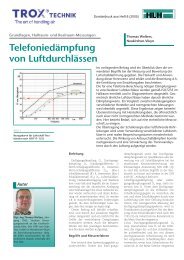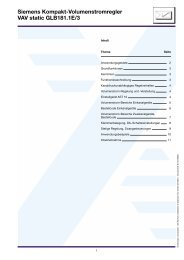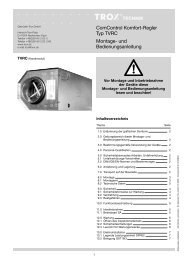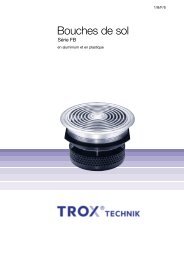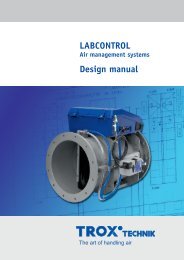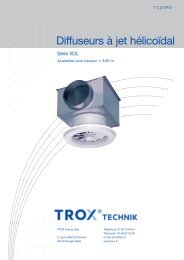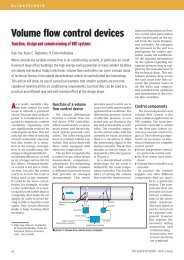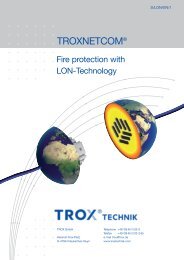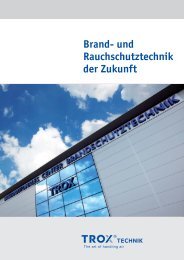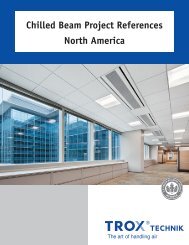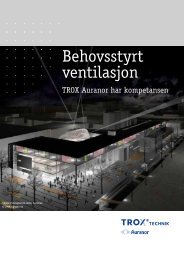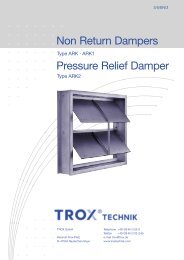ASHRAE Journal: Designing Chilled Beams for Thermal ... - TROX
ASHRAE Journal: Designing Chilled Beams for Thermal ... - TROX
ASHRAE Journal: Designing Chilled Beams for Thermal ... - TROX
Create successful ePaper yourself
Turn your PDF publications into a flip-book with our unique Google optimized e-Paper software.
or equal to 6 ft (1.8 m) can be sized such that their throw to a<br />
terminal velocity of 150 fpm (0.75 m/s) does not exceed half<br />
the distance to a beam with an opposing discharge.<br />
Figure 3 can be used to determine the maximum collision<br />
velocity that limits velocities within the occupied zone to 50<br />
fpm (0.25 m/s) or less <strong>for</strong> any given distance H1 using the following<br />
equation:<br />
V C = 50 / (V H1 / V C ) (4)<br />
where V H1 / V C is the value from Figure 3 that corresponds to<br />
the distance H1.<br />
For example, if H1 is equal to 4 ft,<br />
V C = 50 / 0.43 = 116 fpm<br />
Room Humidity Design Considerations<br />
The sensible cooling contribution with chilled beams af<strong>for</strong>ds<br />
the designer an opportunity to significantly reduce the<br />
primary airflow rate compared to all air systems. As 50% to<br />
75% of the sensible heat gains are typically removed by the<br />
chilled water coil, proportional reductions in the primary<br />
airflow rates within the system may be achievable. However,<br />
this should be done with caution as the beam must also deliver<br />
sufficient ventilation air and maintain acceptable space<br />
humidity levels. The primary airflow rate to the room must<br />
be the greater of that required to (1) ventilate the space in<br />
con<strong>for</strong>mance to <strong>ASHRAE</strong> Standard 62.1-2007 6 (or other<br />
applicable ventilation codes); (2) offset space latent gains<br />
to control the room humidity level within <strong>ASHRAE</strong> Standard<br />
55-2004 recommendations; and (3) provide sufficient<br />
sensible cooling to complement the sensible heat removed<br />
by the chilled water coil.<br />
In most common interior space applications, the primary<br />
airflow rate required to offset space latent gains will exceed<br />
both the ventilation airflow rate and the airflow rate required<br />
to complement the coil’s sensible cooling. The space airflow<br />
rate will be determined by the latent gains and the design<br />
room humidity ratio (W ROOM ). In perimeter spaces, the<br />
primary airflow rate to the beams will be driven by the sensible<br />
load (laboratories may be exceptions due to their high<br />
mandated ventilation rates). The use of beams whose water<br />
side cooling capacity contributes to more than about 65%<br />
of the total space load may be impractical due to architectural<br />
constraints that limit the installed beam quantities and<br />
lengths in these spaces. The goal of the design should be to<br />
reduce the primary airflow rate to as close to the required<br />
ventilation rate as possible.<br />
<strong>Designing</strong> chilled beam systems to maintain room air humidity<br />
levels lower than necessary can result in considerably<br />
higher primary air requirements. Figure 4 is presented in<br />
Standard 55-2004 7 and prescribes acceptable ranges of room<br />
temperatures and humidity ratios. Assuming a clothing level<br />
of 1.0 clo (0.15 m 2 · k/W), this diagram defines the thermal<br />
com<strong>for</strong>t window <strong>for</strong> a dry-bulb temperature of 75°F (24°C)<br />
to include room dew-point temperatures as high as 62°F<br />
Distance H1 (ft)<br />
7.0<br />
6.5<br />
6.0<br />
5.5<br />
5.0<br />
4.5<br />
4.0<br />
3.5<br />
3.0<br />
2.5<br />
0.3 0.4 0.5 0.6 0.7<br />
V H1 /V C<br />
Figure 3: Velocities entering the occupied zone.<br />
Figure 4: <strong>ASHRAE</strong> Summer and Winter Com<strong>for</strong>t Zones. Acceptable<br />
ranges of operative temperature and humidity with air speed ≤ 40<br />
fpm (≤0.20 m/s) <strong>for</strong> people wearing 1.0 and 0.5 clo (0.15 m 2 · k/W<br />
and 0.08 m 2 · k/W) clothing during primarily sedentary activity<br />
(≤1.1 met [≤63.9 W/m 2 ]). 8<br />
(16.7°C). Where chilled beams are applied, the room dewpoint<br />
temperature must not exceed the chilled water supply<br />
temperature, so design <strong>for</strong> dew points above about 57°F (14°C)<br />
is not recommended.<br />
Most conventional HVAC systems condition delivered air to<br />
about a 52°F (11°C) dew-point temperature, which coincides<br />
with a humidity ratio (W PRIMARY ) of 58 grains (3.8 g). The<br />
airflow rate (Q PRIMARY ) to offset the space latent heat gains<br />
(q LATENT ) can be determined by Equation 5.<br />
Q PRIMARY = q LATENT / [0.68 × (W ROOM – W PRIMARY )] (5)<br />
Using this equation and assuming the humidity ratio of the<br />
primary air is 58 grains (3.8 g), the primary airflow requirement<br />
6 2 A S H R A E J o u r n a l a s h r a e . o r g O c t o b e r 2 0 0 9





